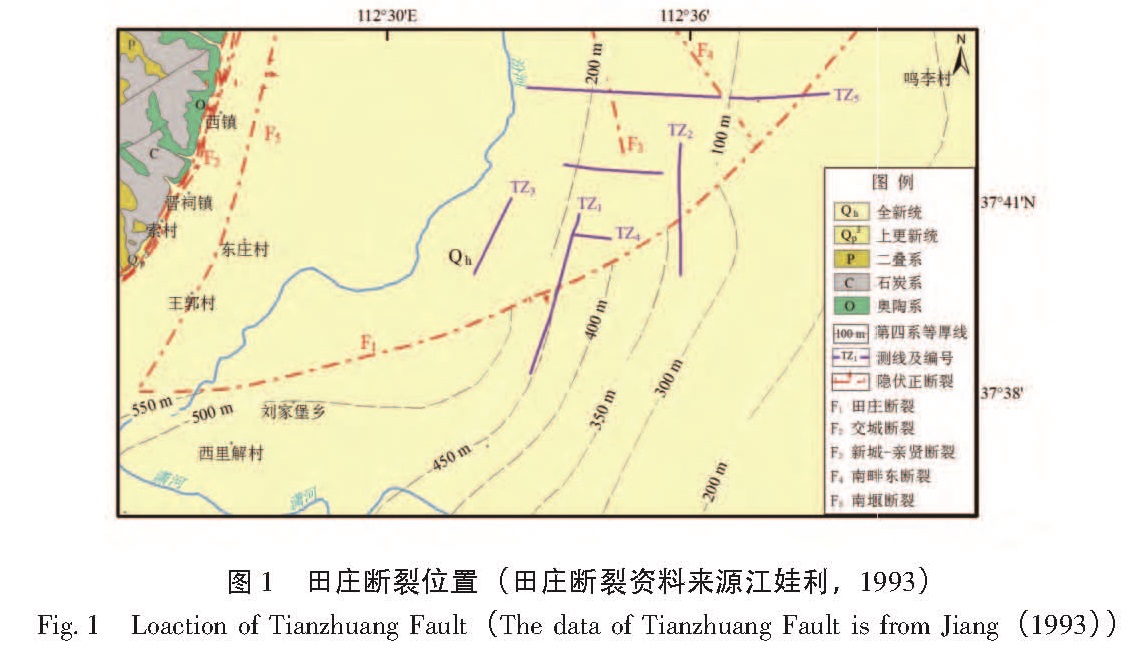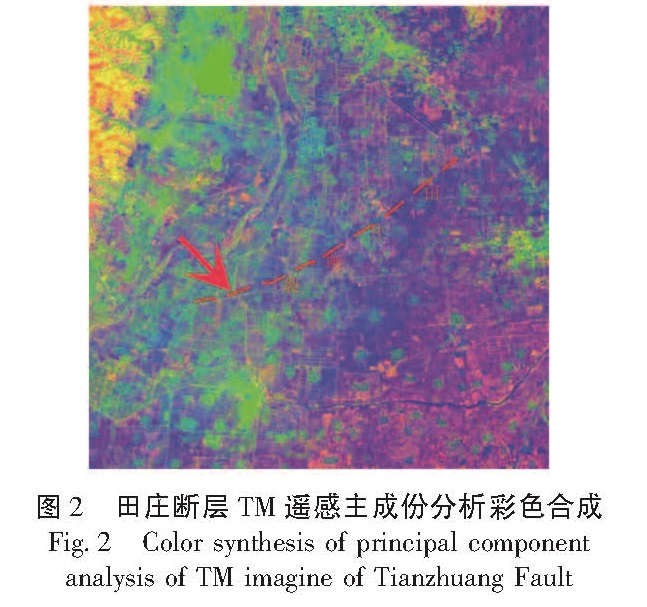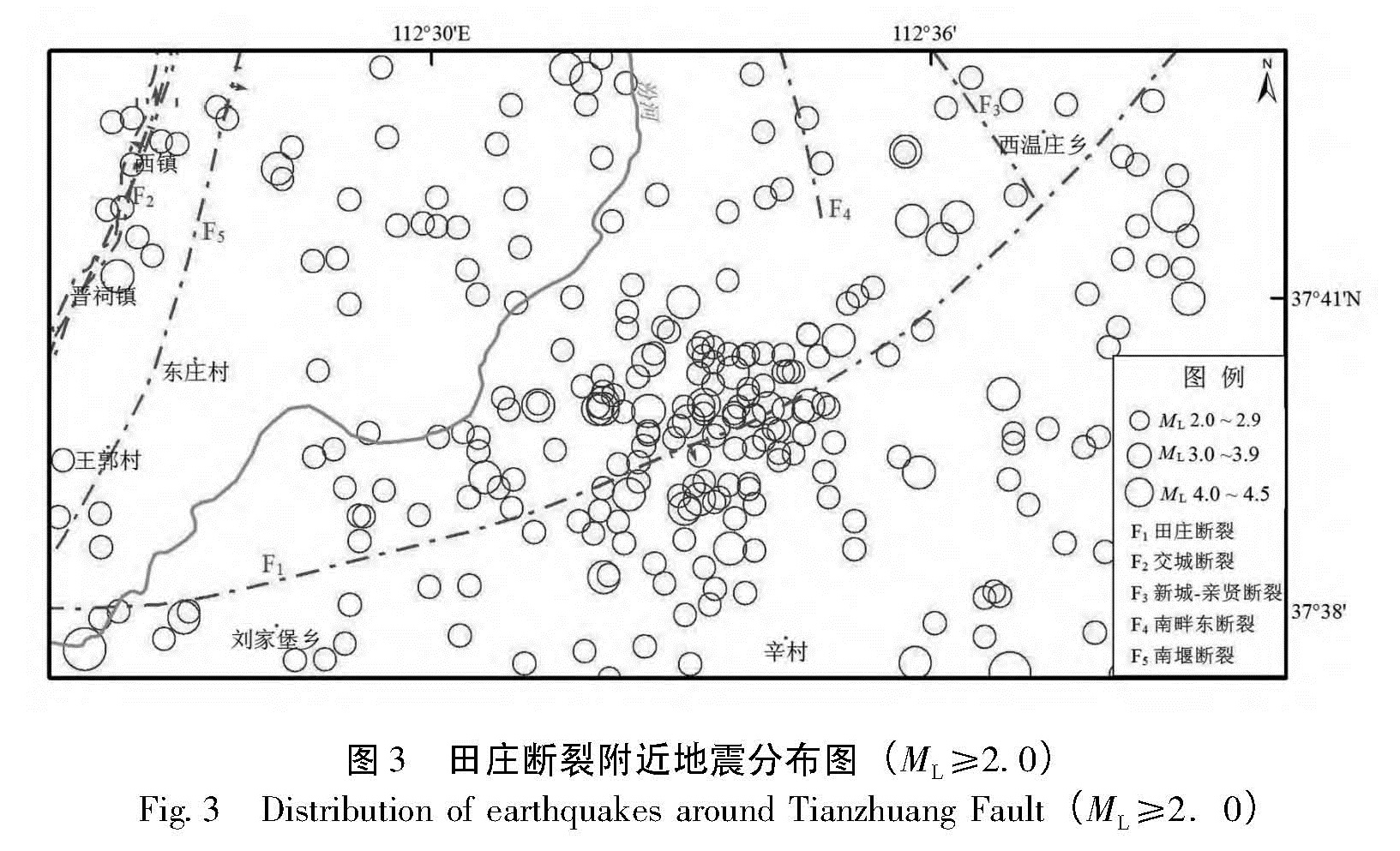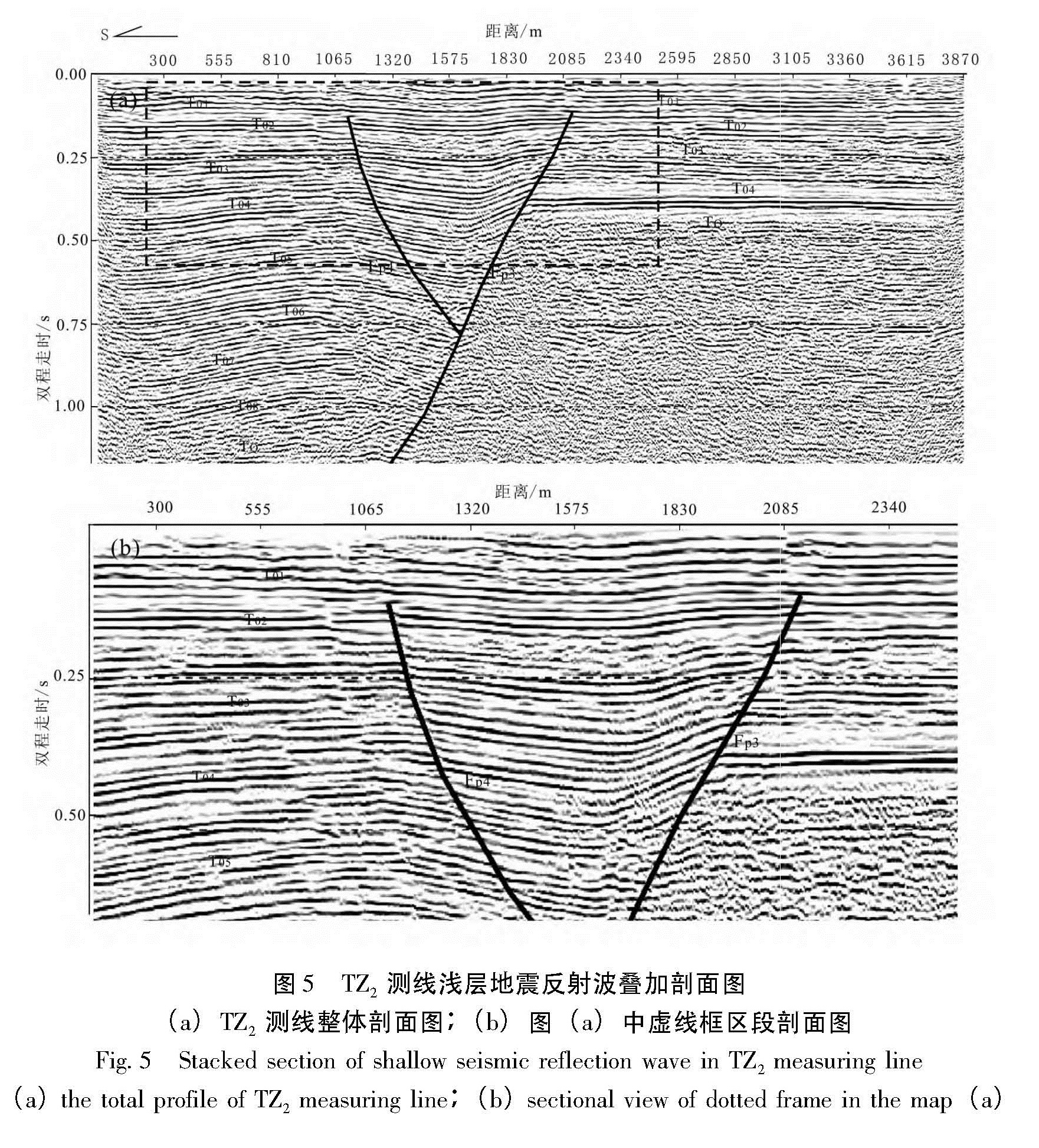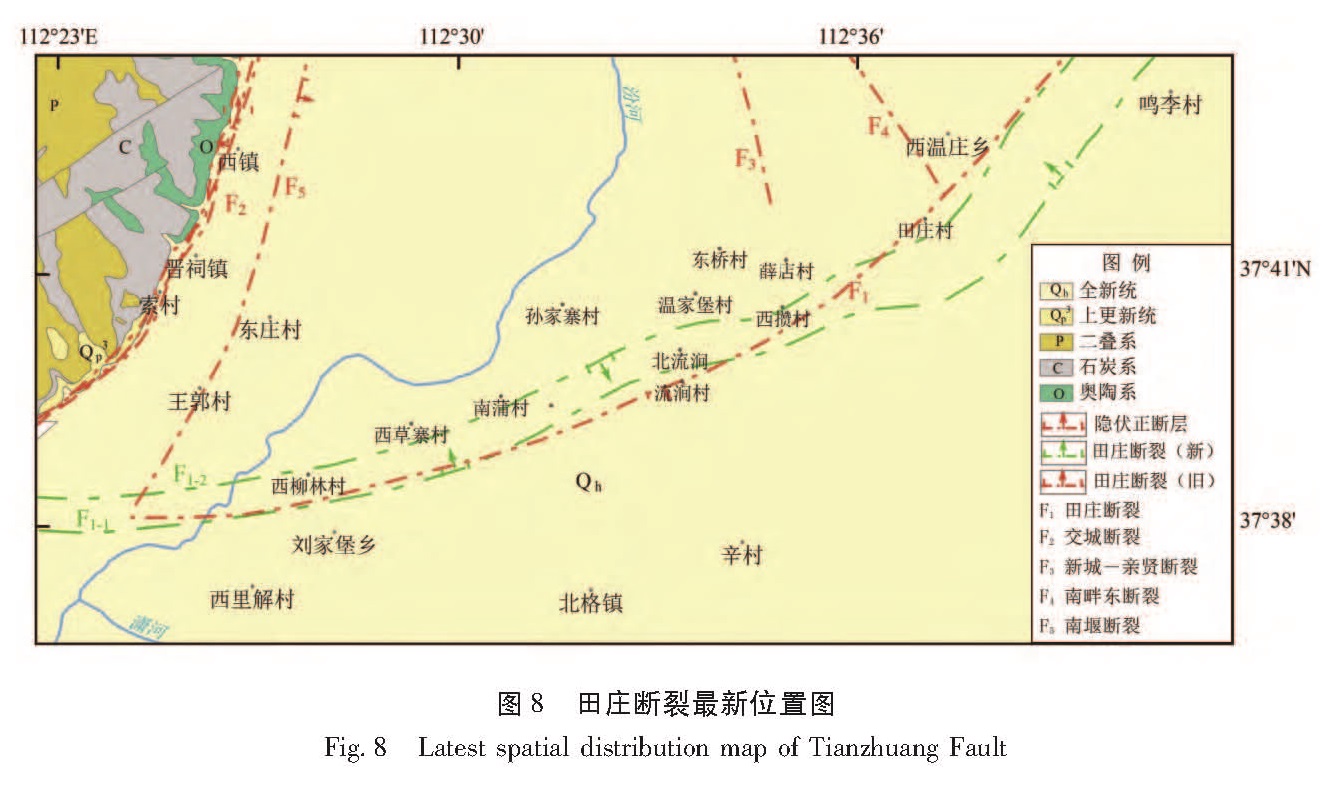基金项目:地震行业科研专项(2014419013)和山西省自然科学基金(2015011084)联合资助.
(1.山西省地震局,山西 太原 030002; 2.太原大陆裂谷动力学国家野外科学观测研究站,山西 太原 030025; 3.北京美辰建筑抗震工程有限公司,北京 100021)
(1.Earthquake Administration of Shanxi Province, Taiyuan 030021, Shanxi, China)(2.National Continental Rift Valley Dynamic Observatory of Taiyuan, Taiyuan 030025, Shanxi, China)(3.Mei Chen Building Seismic Engineering Limited Liability Company of Beijing,Beijing 100029, China)
Tianzhuang Fault; geological survey; shallow seismic exploration; spatial position; fault activity
备注
基金项目:地震行业科研专项(2014419013)和山西省自然科学基金(2015011084)联合资助.
田庄断裂为太原盆地内一条较大的隐伏断裂,采用地质调查、浅层地震勘探等方法对该断裂东段(西温庄—滨河东路)开展研究。地质调查结果显示:田庄断裂对太原断陷盆地的地貌形态有明显的控制作用,并且控制着太原盆地的沉降; 浅层地震勘探结果揭示:该断裂空间位置比原来认定的位置向北偏移了约250~600 m,并且在其上盘发育有与主断裂倾向相反的次级断裂。结合TZ2测线北侧附近“太原市活断层探测与地震危险性分析”项目中小店区钻孔联合剖面地层测年资料,认为该断裂错断了上更新统下部地层,并且上断点埋深有向浅部延展的趋势,初步认为田庄断裂的最新活动时代为晚更新世。
Tianzhuang Fault is a large buried fault in Taiyuan Basin and its east segment(from Xiwenzhuang to Riverside east Road)is studied through geological survey and shallow seismic exploration methods. The geological survey results shows that Tianzhuang Fault had the significant control on the landform of Taiyuan basin and the sedimentation of Taiyuan basin. The shallow seismic exploration results reveals that the spatial location of the fault had a northward shift about 250~600 m than the original location, and the secondary fault with contrary dip direction to main fault formed in the upper side of the fault. Combined with the stratigraphic dating data of drilling combined whit the section of the project “Taiyuan Active Fault Detection and Seismic Hazard Analysis” around the north side of the survey line TZ2 in Xiaodian area, we considered that the fault dislocated the lower strata of the upper Pleistocene series, and the depth of the upper breakpoint had a trend of extending to the shallow. We preliminary think that the latest activity era of Tianzhuang Fault is late Pleistocene.
引言
太原市城区位于太原断陷盆地的北端,盆地内断裂发育,其中田庄断裂就是盆地内一条规模较大的隐伏断裂。2007年太原市完成了活断层探测与地震危险性评价项目,由于经费和当时城市规划等原因,未对该断裂做详细的研究,但随着太原城市发展的加快以及主体城区的南移,田庄断裂进入了城区范围,对其准确的空间位置和活动特征研究将有利于城市规划和重大工程项目选址。
国内不少学者和单位针对田庄断裂的形成、空间展布以及活动特征作过不同程度的研究,但缺乏系统性研究工作。田庄断裂最早是根据石油物探、地质、遥感等资料证实其存在的,研究认为该断裂西起太原市晋源区田村以西,经候家寨至田庄,全长约35 km。走向由西向东呈近EW—NEE—NE向变化,倾向SE,为一高角度正断层①②。江娃利等(1993)的研究资料表明:田庄断裂位于太原断陷盆地的转折部位,是交城断裂向北东延伸的部分,断裂两侧全新统和上更新统厚度基本相同,下更新统和中更新统厚度存在明显差异,活动时代在上新世至第四纪中更新世; 杨承先(1996)认为该断裂是盆地内晋中凹陷和太原凹陷两级构造单元的分界线; 李自红等(2009, 2014)研究认为上新世以来,该断裂以北断陷幅度为200~1 000 m,以南断陷幅度为1 200~3 600 m,上新统底界的垂直差异(断距)达1 000~2 500 m。
2012年太原市拟建的轨道交通2号线横跨田庄断裂,为了查清田庄断裂的空间位置和活动特征,围绕该断裂东段(西温庄—滨河东路)开展了一定程度的探测工作。通过浅层地震勘探确认了该断裂东段的空间位置。本文依托项目探测结果,结合“太原市活断层探测与地震危险性评价”项目中钻孔联合剖面获得的测年资料以及太原盆地地层沉积特征,对田庄断裂的活动时代进行了初步确定。研究结果表明,该断裂的空间位置与前人的研究成果相比有较大的变化,活动时代由原来认定的中更新世初步判定为晚更新世,这一结论为太原市小店区的规划建设提供了重要的参考依据,也为太原市的地震危险性的重新确定提供了地震学参考。
1 田庄断裂附近地质地貌和地震活动
性特征
1.1 地质地貌特征通过对田庄断裂附近的地质调查,发现田庄断裂对太原断陷盆地地貌形态有着明显的控制作用,太原盆地在断裂以北相对较窄,宽度仅10~20 km,在断裂以南宽度达45 km。该断裂对汾河和潇河也有明显的控制作用:汾河由北向南流经田庄断裂附近时向西转折,形成东西向的河湾,跨过断层后又转为南北向; 潇河由晋中市榆次区东山流出后与田庄断裂近平行展布,于断裂南部(上盘)4 km,即在田庄断裂和南堰断裂的交会处流入汾河(图1)。从田庄断裂对河流的控制作用分析,田庄断裂上盘相对低凹,表明其上盘仍在沉降接受冲洪积。
通过对田庄断裂遥感图像进行主成分分析,断层两侧地貌存在单元色调变化,断层迹像清晰,呈蓝色条带状,两侧含水性差异明显(图2)张景发.2007. 太原市区域遥感图像处理与活动构造解译报告.。
图1 田庄断裂位置(田庄断裂资料来源江娃利,1993)
Fig.1 Loaction of Tianzhuang Fault(The data of Tianzhuang Fault is from Jiang(1993))刘媛媛等(2014a、b)、张希等(2013)通过对PS-InSAR资料和GPS水平运动场资料的研究,认为田庄断裂两侧存在明显的差异性形变,这再次证明太原市的沉降受田庄断裂的控制。
1.2 地震活动性特征分析田庄断裂带沿线小震密集,震群活动突出,自1970年以来,共有8次震群活动(图3)。1973~1979年北格一带共有5次震群活动,其中1976年北格ML3.7震群的规模最大,从6月19日至10月20日,历时115天,共记录到地震683次,其中3.0≤ML≤3.9地震10次,2.0≤ML≤2.9地震70次,ML≤2.0地震603次; 1979年榆次ML3.3震群和1991年榆次ML3.4震群,各发生ML≥3.0地震1次; 1983年太原ML4.4震群,历时86天,共记录到地震65次,其中ML≥4.0地震1次,3.0≤ML≤3.9地震2次。郑鹄(1984)通过研究太原区域地震活动特征,认为该区地震活动受北东向构造的控制。
图2 田庄断层TM遥感主成份分析彩色合成
Fig.2 Color synthesis of principal component analysisof TM imagine of Tianzhuang Fault图3 田庄断裂附近地震分布图(ML≥2.0)
Fig.3 Distribution of earthquakes around Tianzhuang Fault(ML≥2.0)通过对田庄断裂附近地质地貌特征、地震活动特征的分析,表明该断裂确实存在。断裂呈NNE走向,大致位置始于西温庄乡,经田庄、刘家堡、西柳林至姚村,与交城断裂相交。
2 浅层地震测线布设与数据采集
3 地震剖面解释及断裂位置确定
3.1 地震剖面解释资料解译中,对反射波组进行地质分层时,参考“太原市活断层探测与地震危险性评价项目”控制性浅层地震勘探报告的资料。地层反射波组分别用T01、T02、T03…、TQ、TN表示,T01、T02、T03…表示第四系内部地层,TQ、TN分别代表第四系底界和第三纪地层,剖面上的断错点用Fp1、Fp2…表示 孙振国.2005. 太原市活断层探测与地震危险性评价项目控制性浅层地震勘探报告.。
(1)TZ1(流涧村)测线
该测线位于流涧村东,时间剖面从上到下解释了11个可以连续追踪的强反射波组,断层信息清晰(图4)。反射界面特征在总体上具有南深北浅的埋深形态。剖面南部TQ界面向北不断抬升,T10和T09界面随着TQ界面的抬升而相继出现尖灭。剖面中部TQ界面基本趋于水平层状形态。在剖面桩号1 200 m两侧,TQ界面存在明显的深度差异,落差达700 m左右; 桩号1 200 m以北,TQ界面呈清晰的水平层状展布,界面连续。结合浅部其它界面的特征分析认为,在剖面北段存在一个视倾向南的正断层。剖面上解释了2个断点:
Fp1断点:在剖面桩号783 m左右、T02及其以下各界面均出现波组同相轴不同程度的错断,从T02以上界面存在微弱变形来看,该断层有继续向上延展的可能,上断点可能更浅。剖面上可分辨的上断点埋深约为105~115 m,垂直断距约为3~5 m。
Fp2断点:在剖面桩号1 806 m处,T02~T05界面也出现错断特征,断点两侧T04和T05界面产状也有差异,断点南部界面呈近水平层状,而断点北部则视倾向南。分析认为此处存在一视倾向北的正断层,该断层下部止于Fp1断层,向上错断了T02界面,与Fp1断层呈Y字形展布特征。可分辨的上断点埋深为100~105 m,垂直断距为5~10 m。
图4 TZ1测线浅层地震反射波叠加剖面图(a)TZ1测线整体剖面图;(b)图(a)中虚线框区段剖面图
Fig.4 Stacked section of shallow seismic reflection wave in TZ1 measuring line(a)the total profile of TZ1 measuring line;(b)sectional view of dotted frame in the map(a)(2)TZ2(太原大学)测线
该测线位于太原大学新校区西侧唐槐公路,从剖面揭示的反射波组来看(图5),TQ以上界面均有不同程度的有规律的起伏变化。TQ界面在剖面北部呈水平层状展布,埋深约320 m,南部则埋深约1 200 m,并有向南继续加深的趋势。在剖面上也有类似于“Y”字形断层特征反映,解释了2个断点:
Fp3断点:该断点位于剖面桩号2 115 m,断层错断至T02界面,断点北侧界面呈水平层状,而南侧界面则视倾向南,该断点为视倾向南的正断层,剖面上可分辨的上断点埋深约为93~98 m,垂直断距约为3~5 m。
Fp4断点:位于剖面约1 050 m处,该断点与Fp3共同构成似Y字形构造,倾向与Fp3相向,为一视倾向北的正断层。其下部在深度约1 131 m时,交于Fp3断层。可分辨的上断点埋深为95~105 m,垂直断距为3~5 m。
(3)TZ3(宋环)测线
该测线布设于宋环村北部的水泥路上,是为控制Fp1断点可能向北东方向的延伸而布设的。在时间剖面上,自上而下解释了6个强的反射波组(图6)。各波组所提示的反射界面基本呈水平层状,西部埋深略大于东部,剖面上各界面横向连续性好,没有出现错断等断层特征。分析认为,该剖面没有断层存在。
图5 TZ2测线浅层地震反射波叠加剖面图(a)TZ2测线整体剖面图;(b)图(a)中虚线框区段剖面图
Fig.5 Stacked section of shallow seismic reflection wave in TZ2 measuring line(a)the total profile of TZ2 measuring line;(b)sectional view of dotted frame in the map(a)(4)TZ4(208国道)测线
该测线呈近南北向布设于208国道,目的是为了控制Fp1断点向西的延伸位置。剖面上TQ以上5个反射波组反射特征清晰(图6),界面特征略呈南深北浅的层状特征,横向连续性好,无错断、突变等断层特征。分析认为,该剖面没有断层存在。
(5)TZ5(2-4小店)测线 孙振国.2005. 太原市活断层探测与地震危险性评价项目控制性浅层地震勘探报告.
该测线布设于小店区的通达西街、通达街以及武洛街,为太原市活断层探测与地震危险性评价布设的一条控制性浅层地震测线。在地震剖面上除了发现了新城—亲贤断裂(Fp19)和南畔东断裂(Fp21)以外,还在桩号8 015 m处发现断层Fp22(图7),断层东西两侧的界面反射存在较大的差异:西侧界面基本水平,东侧明显向西倾斜,存在一条视倾向向东的正断层,可视上断点埋深约125~130 m。对比TZ2、TZ3测线的测试结果,该断裂与Fp3、Fp1特征相似,应为同一断层的反映,即田庄断裂北侧断裂(F1-2)。由于该测线长度有限,在剖面上未揭示南侧断裂(F1-1)。
图6 TZ3(a)、TZ4(b)测线浅层地震反射波叠加剖面图
Fig.6 Stacked section of shallow seismic reflection wave in TZ3(a), TZ4(b)measuring lines图7 TZ5测线浅层地震反射波叠加剖面图(a)TZ5测线地震反射剖面图;(b)图(a)中虚线框区段剖面图
Fig.7 Stacked section of shallow seismic reflection wave in TZ5 measuring line(a)the total profile of TZ5 measuring line;(b)sectional view of dotted frame in the map(a)3.2 田庄断裂东段空间位置的确定综合5条浅层地震勘探测线的结果,本次除探测到田庄断裂的主断裂(F1-2)外,还在浅部探测到田庄断裂的次级断裂(F1-1),且两条断裂基本成平行走向。北部主断裂(F1-2)倾向南东,南部次级断裂(F1-1)倾向北西。田庄断裂带总体宽800~1 000 m,东起西温庄乡,沿NE走向至西攒村,走向产生转变,由NE向转为近WE,经宋环村、杜家寨后走向再次改变为NEE,后又经东蒲村北、西柳林村至本次研究的西边界滨河东路(图8)。
对比本次研究结果与前人研究成果,对田庄断裂带的空间位置有了以下新的认识:(1)走向发生改变:通过探测发现,田庄断裂带的走向由西往东并不是前人认定的EW—NEE—NE向,在小店区内断裂带的走向为NEE—WE—NNE。(2)空间位置发生改变:田庄主断裂位置向北偏移约250~600 m。(3)探测结果显示,断层错断的上断点埋深为93~105 m,并且有向上延展的趋势。(4)除主断裂外,田庄断裂发育一条与主断裂倾向相反的次级断裂(F1-1),这也符合大型铲形正断层的上盘为了消除沿弯曲断层面位移所产生的反牵引作用,会形成与主断裂断面倾向相反的次级伴生断层这一规律(方良好等,2015)。
4 最新活动时代初步确定
根据前人的研究成果,江娃利等(1993)、李自红等(2009)认为田庄断裂的活动时代为上新世至第四纪中更新世,为非活动断裂。本次研究在采用浅层地震勘探所确定断裂上断点埋深的基础上,结合太原断陷盆地的太原凹陷第四系地层的沉积特征和太原市活断层探测与地震危险性评价项目中小店钻孔联合剖面中钻孔揭示的地层资料,来初步确定田庄断裂的活动时代。
太原断陷盆地是叠加于中生代构造背景上的新生代断陷盆地。根据山西省地质局石油普查勘探队的资料 山西省地质局石油普查勘探队.1978. 晋中断陷第四系汾河群底板深度图.和倪倩(2008)的研究成果,盆地第四系地层沉积在南北和东西方向上各有特征。东西方向上:受盆地两侧边界断裂活动强弱差异的影响,西侧交城断裂强烈活动造成盆地西侧快速断陷,沉降幅度大,沉积物厚度大; 盆地东侧的断裂活动相对较弱,沉降幅度较小,沉积物厚度也远小于西部。南北方向上:以田庄断裂为界,断裂以北,第四系底板相对平缓,并且在南北方向上与第四系等深线基本保持一致(图1); 断裂以南第四系底板则明显向西倾斜。总体来说,太原盆地第四系地层表现为西厚东薄的特征,探测区位于的太原凹陷属太原断陷盆地的中央,断裂北面地层表现为南北方向地层界面平缓,东向方向西厚东薄的特点。又根据太原轨道交通2号线施工的呈南北走向的4个地铁站(康宁街站、化章街站、人民南路站、小店站,位于TZ1测线西约300 m)的地震钻孔揭示的地层显示,该区段地层南北向全新统、上更新统地层平缓 曾金艳. 2012. 太原市轨道交通2号线地震安全性评价报告.,与第四系等深线反映的特征相吻合。
基于以上原因,可以选取位于TZ2测线北侧附近小店钻孔联合剖面中揭示的地层资料,来初步确定田庄断裂第四纪以来的活动特征。小店钻孔联合剖面的第四纪地层沉积遵循从细到粗的沉积循环特征,对照年龄样品的测试结果(表2)分析如下 李自红. 2007. 太原市活动断裂探测和地震危险性评价工程技术报告.: ①全新统(Qh):中上部地层为黄褐色粉土、粉质粘土、粉土; 下部地层为黄褐色粉砂层组成,粒度向下逐渐变粗,构成一个完整的旋回。该统厚19.20~20.01 m,底界埋深19.20~20.01 m。②上更新统(Qp3):为一套灰褐、褐黄色的细粒堆积,构成一个大的沉积旋回,由3个次级旋回组成。上部主要由粉土、粉质粘土、粉砂组成,粒度由上向下变粗,构成一个次级旋回; 中部主要有粉土、粉质粘土、粉细砂组成,粒度由细变粗,呈现较为完整的次级沉积旋回; 下部主要由粉土、粉质粘土、粉细砂、细砂组成,粒度由细变粗,构成较为完整的次级沉积旋回。该统厚75.01~75.60 m,底界埋深94.80~95.2 m。
根据田庄断裂东段浅层地震勘探的结果,断层上断点埋深最浅约93.0 m,该深度对应的地层为上更新统下部地层,因此初步判定田庄断裂的最新活动时代为晚更新世。
表2 小店区联合钻孔剖面年龄样品测试结果
Tab.2 Age test results of the samples of combined drilling profile in Xiaodian area样品编号 野外编号 土样名称 取样深度/m 14C年代/aA07313(X1) X1-14C-2# 粉土 3.85~4.00 9 765±40BA07315(X1) X1-14C-6# 粉土 11.85~12.00 10 195±165BA07318(X1) X1-14C-12# 粉土 23.85~24.00 14 780±120BA07319(X1) X1-14C-14# 粉质粘土 27.85~28.00 22 910±230BA07321(X1) X1-14C-18# 粉质粘土 35.85~36.00 25 385±95
5 结论与讨论
综合野外地质地貌调查、浅层地震勘探以及地层分析对比,可以获得以下结论:
(1)田庄断裂确实存在,但其空间位置与前人的研究结果有所变化,最新勘探结果显示该断裂往北移动了250~600 m。
(2)田庄断裂东段(西温庄—滨河东路)由两条断裂组成,北侧断裂为主断层,倾向南东,南侧断裂为次级伴生断裂,倾向北西,形成小型地堑。断裂经西温庄至西攒村后产生扭转,断裂走向由NE向变为近EW向,经宋环村、杜家寨走向转为NEE向,经西柳林村至滨河东路。
(3)初步判定田庄断裂为一晚更新世活动断裂。根据浅层地震勘探结果以及太原市活断层探测和地震危险性钻孔联合剖面获得的地层测年资料,认为田庄断裂错断了上更新统下部地层,初步判定该断裂的活动时代为晚更新世。
(4)由于本次研究并没有进行跨田庄断层钻孔联合剖面探测,断裂的活动时代确定是以太原盆地第四系地层的沉积特征和附近钻孔所揭示的地层时代为依据,并且错断的第四系地层仅在TZ2测线上有反映,综合上述原因,本次研究对断裂活动时代的判定仅为初步判别结果,其可靠程度相对稍低。根据现代小震活动特征和太原断陷盆地沉降变形特征,并结合浅层地震勘探剖面上断点有向浅部延展的趋势,推断田庄断裂现今仍然处于弱活动状态。确定田庄断裂准确的活动时代需进行更深入的工作,如开展跨断层钻孔联合剖面勘探等,以进一步提供断裂活动特征的地质证据。
- 方良好,袁道阳,邵延秀等.2015. 云南西南部黑河断裂晚第四纪分段活动特征[J].地震研究,38(4):558-567.
- 江娃利, 聂宗笙,张康富等.1993. 山西省交城断裂全新世活动证据及第四纪活动历史[C]//地壳构造与地壳应力文集.北京:地震出版社,98-104.
- 李自红,陈文,曾金艳等.2009. 超长电磁波法在隐伏断裂探测中的应用[J].山西地震,(1):21-24.
- 李自红,曾金艳,冉洪流等. 2014. 交城断裂带北段最大潜在地震发震概率评估[J].震灾防御技术,9(4):770-781.
- 刘媛媛.2014a. 基于多源SAR数据的时间序例InASR地表形变监测研究 [D].西安:长安大学.
- 刘媛媛,张勤,赵超英等.2014b. PS-InSAR 技术用于太原市地面沉降变形分析[J].大地测量与地球动力学,34(2):6-9.
- 倪倩.2008. 太原盆地地质结构及其演化[J].科技情报开发与经济,18(29):116-121.
- 杨承先.1996. 太原盆地构造格局及其与地震活动水平的新认识[J].华北地质矿产杂志,11(11):226-232.
- 郑鹄.1984. 太原区域地质构造及地震活动特点[J].山西地震,(3):1-4.
- 张希,郝明,贾鹏等. 2013.全国主要构造区GPS水平运动负位错反演与应变积累特性[J].地震研究, 36(1):1-8.
